Sailing Glossary and More
A B C D E F G H I J K L M N O P Q R S T U V W Y Z
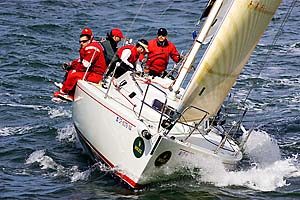
Sailing Terms
A
Abaft Toward the rear (stern) of the boat. Behind.Abeam Direction at a right angle to the centerline of the boat.
Aboard On or within the boat.
About Across the wind in relation to the bow. When a sailboat tacks into the wind to bring it from one side to the other, she is said to go about.
Above Deck On the deck (not over it see ALOFT)
Abreast Side by side; by the side of.
Adrift Floating free. A boat which can not move by its own power.
Aft Toward the back of the boat
Aground Touching or fast to the bottom.
Ahead In a forward direction.
Aids To Navigation Artificial objects to supplement natural landmarks indicating safe and unsafe waters.
Alee Away from the direction of the wind.
Aloft Above the deck, overhead on the mast or in the rigging.
Amidships The middle area of the boat.
Anchorage A place suitable for anchoring in relation to the wind, seas and bottom.
Angle of attack The angle of a sail in relation to the direction of the wind.
Angle of Heel The degree of list a vessel has when underway.
Apparent wind The difference between natural and movement generated wind.
Ashcroft Construction Double diagonal planking system with the planks of both skins raking in the same direction.
Aspect Ratio The relationship between the sails height (luff ) and length along the foot. -high aspect ratio means a sail that is tall and narrow, low aspect ratio is a short, wide sail.
Astern Backwards, somewhere behind the vessel, or towards or behind the stern.
Athwartships Across the boat from side to side.
Avast Command meaning "stop what you're doing"
Aweigh The position of anchor as it is raised clear of the bottom.
B
Back Rabbett The surface against which the side of a plank lies in a rabbetted member. The end fastenings of the plank penetrate the back rabbett of a stem or sternpost; the lower or inner edge fastenings of a plank penetrate the back rabbett of a keel or horn timber.Back stay A cable supporting the mast, from stern to the top of the mast.
Backbone The "spine" of the hull from which the frames radiate.
Bad air The turbulent or disturbed air that exists to the leeward of a boat under sail.
Baggywrinkle Clumps of frayed rope that protect the sails from chafing against the lines.
Bale A fitting on the end of a spar, such as the boom, to which a line may be led.
Ballast Weight below decks that keeps the boat upright.
Ballast Added weight either within or external to the hull added to improve the stability of a vessel or bring it down to its designed lines.
Ballast Weight usually metal, placed low in a boat to provide stability.
Barber Hauler A line attached to the jib or jib sheet, used to adjust the angle of sheeting by pulling the sheet toward the centerline of the boat.
Barging An attempt by a boat to squeeze in causing another boat to have to react to avoid a collision.
Bastard Sawn Hardwood lumber in which the annual rings make angles of 30 degrees to 60 degrees with the surface of the piece.
Batten A thin flexible piece of wood.
Batten Down Secure hatches and loose objects for approaching bad weather.
Battens Strips of wood or other materials used to support a sail or sail area.
Beam The widest dimension of a boat's hull.
Beam A structural member supporting a load applied transversely to it. The transverse members of a deck framing system; the width of a vessel.
Beam Reach A point of sail where the boat is sailing at a right angle to the wind (wind coming from abeam).
Bear off Steer away from the wind, shore or object. To steer a new course further off the wind.
Bearding Line The line formed by the intersection of the inside of the planking with the side or face of the keel.
Bearding LineBeam Knee A gusset like member used to connect a beam to a frame.
Bearing The direction of an object expressed either as a true bearing as shown on the chart, or as a bearing relative to the heading of the boat.
Beat (also) Beating To sail towards the wind by making a series of tacks. -Sailing close hauled.
Below Beneath the decks, i.e., inside a cabin or in a hold.
Bending Steam The process of forming a curved wood member by steaming or boiling the wood and bending it to a form.
Bight The part of the rope or line, between the end and the standing part, on which a knot is formed.
Bilge Hull area between the keel and the boats sides.
Bilge Boards Similar to centerboards, and used to prevent lee way.
Bilge Plank A strengthening plank laid inside or outside of a vessel at the bilge's turn; also known as"Bilge Stringer".
Bilgeboards are on either side of the centerline at the bilges.
Binding Strake An extra thick strake of side or deck planking.
Binnacle A support for the compass, raising it to a convenient position.
Bitter End The last part of a rope or final link of chain. The end made fast to the vessel, as opposed to the "working end", which may be attached to an anchor, cleat, other vessel, etc.
Blow a halyard To simply let a halyard run free when dousing a sail.
Board boat A small boat, usually mono rig. May have a shallow cockpit well. Typically has almost no freeboard.
Boat Generic name for all water vessels. A boat is a small open vessel, compared to a ship that has decks and cabins.
Boat Hook A short shaft with a fitting at one end shaped to facilitate use in putting a line over a piling, recovering an object dropped overboard, or in pushing or fending off.
Bobstay Wire Stay underneath the bowsprit; helps to counteract the upward pull exerted by the forestay.
Boom A pole running at a right angle from the mast supporting the sails foot.
Boom Crutch Support for the boom, holding it up and out of the way when the boat is anchored or moored. Unlike a gallows frame, a crutch is stowed when boat is sailing.
Boom vang A device used to keep the boom from rising.
Boomkin (bumpkin) Short spar extending aft from the transom. Used to anchor the backstay or the sheets from the mizzen on a yawl or ketch.
Boot Top A painted stripe that indicates the waterline.
Bosun's Chair A seat attached to a halyard to raise and lower someone to work on the mast.
Bow The front area of a boat.
Bow Line A docking line leading from the bow.
Bowline A knot use to form an eye or loop at the end of a rope.
Bowsprit A short spar extending forward from the bow. Normally used to anchor the forestay.
Box Section Mast A hollow mast of round, square or rectangular section made up of long strips of wood.
Brale Partially furling sails to lessen wind resistance or partially unfurling sails to make them ready for instant use. On a square sail this is accomplished with leech and clew lines. See "Scandalize"
Breakers Waves breaking over rocks or shoals. A wave that approaches shallow water, causing the wave height to exceed the depth of the water it is in, causing a cresting wave with water tumbling down the front of it.
Breasthook Timber knees placed horizontally between two fore ends of stringers to reinforce their connection to the stem.
Bridge The location from which a vessel is steered and its speed controlled. "Control Station" is really a more appropriate term for small craft.
Bridge Deck The transverse partition between the cockpit and the cabin.
Bridle A short length of wire with a line attached at the midpoint. A bridle is used to distribute the load of the attached line. Often used as boom travelers and for spinnaker down hauls.
Brightwork Varnished woodwork and/or polished metal.
Bring About To reverse or change directions, to turn around.
Broach The turning of a boat out of control, broadside to the wind or waves.
Broad Reach A point of sail where the boat is sailing away from the wind, but not directly downwind with the sails let out nearly all the way.
Bubble The effect created by easing a sail so the leading edge is blown slightly to windward without blogging. Used to decrease power without reefing
Bulkhead A watertight vertical partition or wall which separates different compartments and adds strength to the hull.
Bullseye A round eye through which a line is led, usually in order to change the direction of pull.
Bulwark A vertical extension above deck level designed to keep water out of and sailors in the boat
Bunk Sleeping Berth
Buoy A floating anchored object used to mark the navigable limits of channels, sunken dangers, isolated rocks, etc.
Burdened Vessel That vessel which, according to the applicable Navigation Rules,must give way to the privileged vessel.
Butt Block A short longitudinal piece of wood used to back up the connection of two plank ends.
Butt Joint An end joint formed by abutting the squared ends of two pieces. Because of the inadequacy in strength of butt joints when glued, they are not generally used.
Buttock That part of a vessel's stern above her waterline which overhangs or lies abreast of the stern post; the counter.
Buttock Lines Lines representing fore and aft vertical sections from the centerline outward.
By the Lee Sailing downwind with the wind blowing over the leeward side of the boat.
C
Cabin A compartment for passengers or crew.Cabin sole The teak and holly floorboards down below.
Camber 1) The curvature of an object such as a sail, keel or deck. 2) The curve of a deck athwartships.
Cant Frames Frames whose plane of support is not perpendicular to the fore and aft line.
Cap A piece of trim, usually wood, used to cover and often decorate a portion of the boat, i.e., cap rail.
Capping Fore and aft finished piece along the topside of an open boat, often improperly termed gunwale; called a covering board, margin plank or plank sheer in a decked vessel.
Capsize When a boat is turned over.
Capstan drum like part of the windlass used for winding in rope, cables, or chain connected to cargo or anchors
Captain The person in charge of a vessel and responsible for it and its occupants.
Carlin The fore and aft members of the deck framing system.
Carvel Planked Smooth skinned planking whose strakes run fore and aft.
Cast Off To let go.
Catamaran A twin hulled boat.
Catboat A sailboat rigged with one mast and one sail.
Caulking (v) Forcing material such as oakum into the seams of planks on a deck or a boats sides to make them watertight. (n) 1) Cotton, oakum, or other fiber driven into planking seams to make them water tight. 2) Silicone, Polyurethane, or polysulfides sealants used to caulk seams.
Ceiling An inner skin of the hull often used to add strength in boats having sawn frames. In some cases the ceiling is not structural but merely serves to line the hull for decorative purposes or for ease in cleaning.
Centerboard A board lowered through a slot in the centerline of he hull to reduce sideways skidding or leeway. Unlike a daggerboard, which lifts vertically, a centerboard pivots around a pin, usually located in the forward top corner, and swings up and aft.
Center line Imaginary line running the length of a boat at the center.
Chafing Gear Tubing or cloth wrapping used to protect a line from chafing on a rough surface.
Chain plate Attachment of shrouds to hull.
Chart A map for use by navigators.
Check A lengthwise separation of the wood that usually extends across the rings of annual growth and commonly results from stresses set up in wood during seasoning.
Chine The line of intersection of the bottom with the side of a vee or flat bottomed vessel.
Chock A fitting through which anchor or mooring lines are led.
Chop Small, steep chaotic waves.
Clamp The fore and aft member at the sheer line of the vessel to which the deck beams usually fasten.
Cleat A fitting to which lines are made fast.
Clench Fastening Securing a nail or rivet by placing a rove (washer) over the inboard side and then bending the fastening over it. In many cases they are simply bent over by driving them against a backing iron, causing them to reenter the frame.
Clench Planking Lapstrake, in which the adjacent planks overlap like clapboards of a house.
Clew For a triangular sail, the aft most corner.
Clinker Built See clench planking.
Close hauled Sailing on-the-wind, on a beat.
Close reach Sailing between a beam reach and close hauled
Clove Hitch A knot for temporarily fastening a line to a spar or piling.
Coach Roof Also trunk. The cabin roof, raised above the deck to provide headroom in the cabin.
Coaming A vertical extension above the deck to prevent water from entering the cockpit. May be broadened to provide a base for winches.
Coamings Built up sides around the cockpit that prevent water from coming in.
Coat, Mast A protective piece, usually canvas, covering the mast wedges where the mast enters the deck.
Cockpit An opening in the deck from which the boat is handled.
Coil To lay a line down in circular turns.
Cold Bent (frames) Frames which are bent on forms and after shaping are fitted to the vessel.
Cold Molded A method of boat construction using a male mold over which layers of thin wood and/or plywood are diagonally laid and glued together. Can be covered with epoxy or FRP.
Come About To change tack when sailing windward.
Companionway The main entrance to the cabin, usually including the steps down into the cabin.
Counter At the stern of the boat, that portion of the hull emerging from below the water, and extending to the transom. Apr to be long in older designs, and short in more recent boats.
Course The direction in which a boat is steered.
Cove Line A hollowed out decorative line found along the sheer of a boat.
Covering Board A plank used as a "washboard" or "plank sheer" along the outer edge of the deck. See Capping.
Coxswain Sailor in charge of and steering a small boat
Crosstrees Horizontal members attached to the mast acting as spreaders for the shrouds
Cuddy A small shelter cabin in a boat.
Cunningham Line that pulls down on the mainsail near the tack to adjust the sail shape.
Current The horizontal movement of water.
Cutwater The forward edge of the stem at the waterline.
D
Daggerboard A board dropped vertically through the hull to prevent leeway. May be completely removed for beaching or for sailing downwind.Danger Zone The area encompassed from dead ahead of your boat to just abaft your starboard beam. You must stand clear of any boat in the "danger zone".
Davits Small cranes used to raise or lower small boats and light items from deck to water level.
Dead Eyes
Dead Ahead A position directly in front of the vessel.
Dead Astern A position directly aft or behind the vessel.
Dead Reckoning also Ded Reckoning. Sometimes believed to be an abbreviation of Deduced Reckoning
Dead Rise The amount the bottom rises from keel to chine
Deadeye A stout disk of hard wood, strapped with rope or iron, through which holes (usually three) are pierced for the reception of lanyards. They are used as blocks to connect shrouds and chain plates.
Deadhead A floating log.
Deadlight Either a cover clamped over a porthole to protect it in heavy weather or a fixed light set into the deck or cabin roof to provide light below.
Deadwood The vertical structure built up from the keel to support the cant frames at the stern or stem; longitudinal timbers of a vessel's structural backbone which lie entirely outside the keel, sternpost, and horn timber rabbett lines.
Decay The decomposition of wood substance by fungi.1. (Advanced or typical)
Deck A covering over a compartment, hull or any part of a ship serving as a floor.
Deck Head The underside of the deck.
Diagonal Planking Planking laid on an angle to the keel.
Dinghy A small open boat. A dinghy is often used as a tender for a larger craft.
Displacement The weight of water displaced by a floating vessel, thus, a boat's weight.
Displacement Hull A type of hull that plows through the water, displacing a weight of water equal to its own weight, even when more power is added.
Distance Made Good Distance traveled after correction for current, leeway and other errors not included in the original distance measurement.
Ditty Bag Small bag used for carrying and stowing small personal items or kits
Dock A protected water area in which vessels are moored.The term is often used to denote a pier or a wharf.
Dodger A screen, usually fabric, erected to protect the cockpit from spray and wind.
Dolphin A group of piles driven close together and bound with wire cables into a single structure.
Down haul Adjusting the tension of a sail's luff.
Down wind The direction the wind is blowing to.
Downhaul A line used to pull a spar, such as the spinnaker pole, or a sail, particularly the mainsail, down.
Draft Distance between the waterline and the lowest part of the keel or hull. -The amount of bend in a sail's shape.
Drift (Pins, Bolts) A long fastening driven (pin) or threaded (bolt) to receive end nuts, used for joining heavy timbers such as horn timbers and stern frames; also used to fasten and reinforce wooden panels on edge, such as rudders and centerboard trunks.
Driver The one steering the boat.
Dry Rot A term loosely applied to any dry, crumbly rot but especially to that which, when in an advanced stage, permits the wood to be crushed easily to a dry powder. The term in actually a misnomer for any decay, since all fungi require over 20% moisture to grow.
Dry Sailing When boats, especially smaller racers, are kept on shore instead of being left anchored or moored, they are dry sailed. The practice prevents marine growth on the hull and the absorption of moisture into it.
Dutchman Wooden block or wedge used to fill the void in a badly made butt or joint; a graving piece or repairing patch in a deck; filler; shim; short plank.
E
Ease the sheets To let a small amount of line out on a jib or the main to get proper shape.Ebb A receding current.
Ebb tide A receding tide.
Edge Joint The place where two pieces of wood are joined together edge to edge, commonly by gluing. The joints may be made by gluing two squared edges as in a plain edge joint or by using machined joints of various kinds, such as tongue-and-grooved joints.
Edge Nailed A method of fastening a strip plank to adjacent planks.
Edge-Grained Lumber Lumber that has been sawed so that the wide surfaces extend approximately at right angles to the annual growth rings. Lumber is considered edged grained when the rings form an angle of 45 degrees to 90 degrees with the wide surface of the piece.
Edging Amount required to be cut away from the edge of a plank in fitting strakes.
End Joint The place where two pieces of wood are joined together end to end, commonly by scarfing and gluing.
Even keel When a boat is floats evenly to its waterline, well balanced.
Eye of the wind The direction that the wind is blowing from.
Eye splice (knots) Braiding the end of a line into itself to form a loop.
F
Facing Building one piece of timber on another for strength or finish purposes.Fairlead A fitting that a line passes through to guide it in a particular direction.
Fall Off To change direction so as to point farther away from the wind.
False Keel Sacrificial batten added to the keel to protect the keel from grounding and from marine borers; eg. worm shoe.
Fathom A unit of measurement relating to the depth of water or to the length of line. -one fathom is 6 feet or 1.83 meters.
Faying Joining closely together.
Fender A cushion, placed between boats, or between a boat and a pier, to prevent damage.
Fid A pointed tool used to separate strands of rope.
Figure Eight Knot A knot in the form of a figure eight, placed in the end of a line to prevent the line from passing through a grommet or a block.
Flare 1) The outward curve of a vessel's sides near the bow. 2) A distress signal.
Flat-Grained Lumber Lumber that has been sawed in a plane approximately perpendicular to a radius of the log. Lumber is considered flat grained when the annual growth rings make an angle of less than 45 degrees with the surface of the piece.
Flood A incoming current.
Floor A major structural member on a boat that goes across the boat from side to side. These support the cabin sole.
Floor or Floor Timber A transverse structural member lying across the keel and tying the frames on either side of the keel together. The central futtock or futtocks of a sawn frame, lying across the keel. Floor timbers join both sides of a vessel together and make up the substructure for external keel fastenings, engine beds, and mast steps.
Floorboards Planking laid on top of the floors to provide a walkway. Also known as the "sole."
Flotsam Debris floating on the water surface.
Fluke The palm of an anchor.
Fo'c'sle An abbreviation of forecastle. Refers to that portion of the cabin which is farthest forward. In square riggers often used as quarters for the crew.
Following Sea An overtaking sea (wind and waves) that comes from astern.
Foot For a triangular sail, the bottom edge.
Foot off Change direction to point further from the wind and make sail adjustments for greater speed.
Fore And Aft In a line parallel to the keel.
Fore-and-aft Direction of centerline of boat
Foremast vertical spar most forward
Forepeak The compartment farthest forward in the bow of the boat. Often used for anchor or sail stowage. In larger ships the crews quarters
Foresail lowest square sail on the foremast
Forestay Wire, sometimes rod, support for the mast, running from the bowsprit or foredeck to a point at or near the top of the mast.
Foretriangle The triangle formed by the forestay, mast, and fore deck.
Foreward Toward the front of the boat.
Forward Toward the bow of the boat.
Fouled Any piece of equipment that is jammed or entangled, or dirtied.
Fractional Rig A design in which the forestay does not go to the very top of the mast, but instead to a point 3/4~ 7/8's, etc., of the way up the mast.
Frame The transverse structure at each section giving form to the hull. Frames connect to the keel or keels on and to the clamp or shelf at the sheer. Also known as "ribs."
Frames Structural pieces that the hull planks are attached to that run from the deck to the keel.
Freeboard The distance between the deck and the waterline. Most often it will vary along the length of the boat. (see: Shear)
Freeing Port Any direct opening through the vessel's bulwark or hull to quickly drain overboard water that has been shipped on exposed decks.
Furl To fold or roll a sail and secure it to its main support.
Futtock Curved parts or sections of transverse frames extending from the floor timbers to the top timbers.
G
Gaff a free swinging spar attached to the top edge of a sailGalley The kitchen area of a boat.
Gangway The area of a ship's side where people board and disembark.
Garboard The strake of planking nearest the keel.
Genoa A large foresail or jib that overlaps the mainsail.
Give Way Vessel
Give Way Together Command used by Coxswain in larger rowing boats
Give-Way To yield the right of way to another boat.
Gollywobbler A full, quadrilateral sail used in light air on schooners. It is flown high, between the fore and main mast, and is also known as a fisherman's staysail.
Gooseneck The fitting that connects the boom to the mast.
GPS - Global Positioning System Method of using satellite signals to fix a position.
Grab Rails Hand
Green Freshly sawed lumber, or lumber that has received no intentional drying; unseasoned. The term does not apply to lumber that may have become completely wet through waterlogging.
Ground Tackle A collective term for the anchor and its associated gear.
Grub Beam A built up beam of short heavy timbers used to shape a round stern.
Gunter Rig Similar to a gaff rig, except that the spar forming the "gaff" is hoisted to an almost vertical position, extending well above the mast.
Gunwale Most generally, the upper edge of the side of a boat.
Gusset Any piece that is used to join or strengthen the joint of two other pieces.
Guy Controls sail to weather, analogous to sheet controlling sail to leeward, used with spinnaker or poled jib.
Gybe To change tack, sailing downwind with the wind crossing the transom instead of the bow as in a tack (also Jibe)
H
Halyard A line that hauls a yard.Halyards Lines used to hoist or lower sails or flags.
Hanging Knee A strengthening bracket used between frames and deck beams.
Hanks Rings or clips used to attach sails to stays.
Hard Chine An abrupt intersection between the hull side and the hull bottom of a boat so constructed.
Harden up Change direction to point closer to the wind, probably also adjust sails.
Hatch an opening in the deck for entering below.
Head For a triangular sail, the top corner. Also a marine toilet.
Head Down To fall off, changing course away from the wind.
Head Knocker A block with a jam cleat, located on the boom and used to control the mainsheet on small boats.
Head to Wind Where the boat is pointed directly into the wind, sails luffing. (Papoose will not do this).
Head Up Change direction to point closer to the wind. The opposite of falling off.
Header An unfavorable windshift that causes the wind to be closer to the bow so that you have to fall off or harden up.
Headfoil a grooved rod fitted over the forestay to provide support for luff of the sailor help support the forestay
Heading The direction the boat is going.
Headsail A sail set forward of the foremast on the headstay.
Headsails Any sail forward of the foremast.
Headstay The stay leading from the mast to the bow.
Headway Forward motion of boat opposite to sternway
Heartwood The wood extending from the pith to the sapwood, the cells of which no longer participate in the life processes of the tree. Heartwood may be infiltrated with gums, resins, and other materials that usually make it darker and more decay resistant than sapwood.
Heave To To stop a boat and maintain position by balancing rudder and sail to prevent forward movement.
Heavy Seas When the water has large or breaking waves.
Heel Leaning of a boat to one side in response to the wind.
Helm The boat's directional controls, tiller or wheel of a boat.
Helmsman The one at the helm.
Hike Leaning out over the side of the boat to counteract heel.
Hiking Stick An extension of the tiller that enables the helms man to sit at a distance from it.
Hitch A knot used to secure a rope to another object or to another rope, or to form a loop or a noose in a rope.
Hold A compartment below deck in a vessel, used solely for carrying cargo.
Horn Timber One or more timbers forming the main support for an overhanging stern and extending aft from the upper end of the stern post. Also used for timber connecting the shaft log and body post with the rudder post.
Horse (n) The form upon which a small boat is built.
Horse (v) To drive home, as to horse caulking.
Hot Frame A frame which, after being softened by heat, is bent into shape as it is installed.
Hull The body, or shell of a boat.
Hull Speed The maximum speed a hull can achieve.
I
In Irons A sailboat with its bow pointed directly into the wind, preventing the sails from filling properly and stopping the boat.Inboard 1) More toward the center of a vessel 2) Inside 3) An engine fitted inside a boat.
Inspection port A watertight covering, usually small, that may be removed so the interior of the hull can be inspected or water removed.
J
Jacobs Ladder A rope ladder, lowered from the deck, as when pilots or passengers come aboard.Jam Cleat A cleat designed to hold a line in place without slipping. -It consists of two narrowing jaws with teeth in which the line is placed.
Jenny A genoa jib. A large jib that overlaps the mast, also Genny.
Jetsam Anything deliberately thrown overboard - debris, jettisoned items, floating at sea.
Jettison To throw overboard.
Jetty A structure, usually masonry, projecting out from the shore; a jetty may protect a harbor entrance.
Jib A triangular sail mounted on a stay from the stem or bowsprit to the mast.
Jib Car A block that is mounted on a track on the deck of a sailboat. The jib sheet goes through one or more jib cars then to the winch.
Jiffy reefing A fast method of reefing. Lines pull down the luff and the leech of the sail, reducing its area.
Joint The junction of two pieces of wood or veneer.
Jumbo The larger of the headsails.
Jumper Stay A short stay supporting the top forward portion of the mast. The stay runs from the top of the mast forward over a short jumper strut, then down to the mast, usually at the level of the spreaders.
K
Keel The very bottom edge of a boat, the structural member that the hull is built on.Keelson A structural member above and parallel to the keel.
Kerf, Kerfing To cut or make a channel with a saw blade.
Ketch A sailboat with two masts, a shorter mizzen mast is aft of the main mast.
Kiln Dried As in timber, refers to forced hot air circulation through a chamber to dry the wood.
King Plank The centerline plank of a deck.
Knee See Hanging Knee.
Knockabout A type of schooner without a bowsprit.
Knockdown To be capsized by the wind or waves.
Knot 1) A speed of one nautical mile (6,076 feet or or 1,852 meters) per hour. 2) A method of attaching a rope or line to itself, another line or a fitting. 3) A knot in wood.
L
Lap Joint A joint made by placing one piece partly over another and bonding the overlapped portions.Lapper A foresail which extends back of and overlapping the mast, such as a 110% genoa jib.
Lapstrake See Clench Planking.
Latitude North or south distance from equator measured in degrees 0 to 90.
Layline Up wind line for beating to the weather mark without pinching.
Lazarette A storage space in a boat's stern area.
Lazy Jack Light lines from the topping lift to the boom, forming a cradle into which the mainsail may be lowered.
Leach The aft edge of a fore-and-aft sail.
Lead Refers to the direction in which a line goes. A boom vang, for example, may "lead to the cockpit."
Lee The side sheltered from the wind.
Lee Boards Pivoting boards on either side of a boat which serve the same function as a centerboard. The board to leeward is dropped, the board to windward is kept up.
Lee mark A mark that is down wind.
Lee rail The boat rail on the down wind side of the boat. The low rail.
Lee Shore Land which is on the leeward side of the boat. A potential danger because the wind will be blowing the boat towards it.
Leech The aft edge of a triangular sail.
Leech Line A line running through the leech of the sail, used to tighten it.
Leeward The direction the wind is going, downwind. Opposite side of windward.
Leeward Mark The mark at the end of the running leg of a windward-leeward racecourse, or following the second of two reaching legs on a triangle racecourse.
Leeway Distance a boat drifts off course due to wind.
Leg The portion of a racecourse between two marks.
Lift A windshift that is favorable so that a higher course can be taken or the sheets can be eased.
Lignum Vitae A hardwood used for deadeyes and propeller shaft bearings.
Limber A hole allowing the free passage of water from one area to another.
Lines Rope or cordage used for various purposes aboard a boat.
Lizard A short line with a loop or a block which another line may be run.
Log A record of courses or operation. Also, a device to measure speed.
Longitude West or east distance from 0 meridian measured in degrees 0 to 180.
Loose Footed
Lubber Line A mark or permanent line on a compass indicating the direction forward parallel to the keel when properly installed
Luff The forward edge of a fore-and-aft sail.
Luff or Luffing when the vessel is brought too far into the wind the trailing edge or Leech of the sail begins to shiver or shake.
Luffing To head into the wind, causing sails to flap and flutter.
M
Main sail (mainsl') The largest sail on a multiple sail boat.Main sheet Line that controls the position of the mainsail.
Mainmast the tallest mast of the ship; on a schooner, the mast furthest aft.
Mainsail The lowest square sail on the mainmast.
Make Fast To attach a line to something so that it will not move.
Make Way Moving through the water.
Making Iron A large caulking iron used to drive oakum into plank seams.
Mark A permanent or movable buoy at the end of a leg or a turning point on a racecourse.
Marline A light twine size line which has been tarred.
Marline Selling A tool for opening the strands of a rope while splicing.
Mast The vertical pole or spar that supports the boom and sails.
Mast Head The top of the mast.
Mast Partners Carlins between deck beams to strengthen the area where the mast passes through the deck.
Mast Step The fitting in the bottom of the boat in which the bottom or heel of the mast sits.
Masthead Rig A design in which the forestay runs to the peak of the mast.
Mechanical advantage (or purchase) A mechanical method of increasing an applied force. Disregarding the effects of friction, if a force of 100 pounds applied to a tackle is magnified to a force of 400 pounds, the purchase or mechanical advantage is said to be four to one, or 4: 1.
Midship Approximately in the location equally distant from the bow and stern.
Mizzen A fore and aft sail flown on the mizzenmast.
Molding Measurement of a plank or timber from inboard to outboard, i.e., parallel to the plane in which the member lies; opposed to siding measured at right angles to such plane. Thus, the molding of a frame is measured in the the athwartship direction while that of a stern piece is its cross sectional dimension fore and aft.
Monkey Deck A false deck built over a permanent deck. Often used in the bow of larger sailing ships, forward of the anchor windlass and provides a working platform around the portion of the bowsprit as it attaches to the ship.
Mooring An arrangement for securing a boat to a mooring buoy or a pier.
N
Nautical Of sailors or navigation.Nautical mile About 6076 feet, aka one minute of Latitude. About 15% longer than a statute mile.
Navigation The art and science of conducting a boat safely from one point to another.
Navigation Regulations (or COLREGS) The regulations governing the movement of vessels in relation to each other, generally called steering and sailing rules.
Nib The squared off end of a tapered piece such as a scarf.
Noble Metal A metal most resistant to deterioration due to galvanic action; the cathodic material.
O
Oakum A caulking material of tarred fibers.Oar Device used to propel small boats by rowing
Off the Wind Sailing with the wind coming from the stern or quarter of the boat.
On the Wind Sailing close hauled. Sailing toward the wind as much as possible with the wind coming from the bow.
One-design Any boat built to certain standards or rules so that is like all others in the same class.
Outboard 1) Toward or beyond the boat's sides. 2) A detachable engine mounted on a boat's stern.
Outhaul An adjuster that tensions the sail's foot.
Overboard Over the side or out of the boat.
Overhaul Straightening out misaligned or partially fouled sails and rigging
Overlap A condition in which a portion of a boat is abeam of any portion of another boat. A boat has overlap if looking directly sideways from the bow there is another boat. If you have overlap, you cannot turn without hitting the other boat (loosely stated).
Overstanding the mark Sailing beyond the layline. Usually a bad thing.
P
Partner Stiffening or supporting pieces fitted in way of the passage of a mast through a deck.Pay Out to feed line over the side of the boat, hand over hand.
Paying The filling of the seam with seam putty, pitch, tar, or other type of seam sealant after caulking it.
Pedestal A vertical post in the cockpit used to elevate the steering wheel into a convenient position
Pier A loading platform extending at an angle from the shore.
Pile A wood, metal or concrete pole driven into the bottom. Craft may be made fast to a pile; it may be used to support a pier (see PILING) or a float.
Piling Support, protection for wharves, piers etc.; constructed of piles (see PILE)
Pilothouse a small cabin on the deck of the ship that protects the steering wheel and the crewman steering.
Piloting Navigation by use of visible references, the depth of the water, etc.
Pinch to sail closer to the wind than one's usual close-haulled course, sacrificing speed in an effort to gain distance to windward usually to avoid a pair of tacks.
Pitch Pocket An opening extending parallel to the annual growth rings containing, or that has contained, pitch, either solid or liquid.
Planing A boat is said to be planing when it is essentially moving over the top of the water rather than through the water.
Planing Hull A type of hull shaped to glide easily across the water at high speed.
Plank Strips of wood that form the "skin" of a boat; strakes.
Plank Sheer See Capping.
Planking wood boards that cover the frames outside the hull.
Planning A boats ability to lift up from the water by diverting water under its hull.
Point of sail The angled position a sail is held to the wind.
Points of sail From into the wind to downwind -- In irons, pinching, close hauled, close reach, beam reach, broad reach, running.
Polar diagram A diagram showing a boat's speed at different angles of sail in different wind strengths. Useful to determine target speed for any given wind speed.
Port The left side of the boat when you are looking forward.
Port tack When the wind is coming from the port side of the boat and the boom is on the starboard side.
Preservative Any substance that for a reasonable length of time is effective in preventing the development and action of wood-rotting fungi; borers of various kinds and harmful insects that deteriorate wood.
Preventer Line to prevent boom from gybing.
Prick Post An outer post supporting an outboard rudder.
Privileged Vessel A vessel which, according to the applicable Navigation Rule, has right of way. The vessel that is required to maintain its course and speed when boats are approaching each other according to the navigation rules. Also known as the stand on vessel.
Proper course The course a boat would sail to finish as fast as possible in the absence of other boats. Sometines thought of as the most direct course to the next mark but that depends on the boats sailing characteristics.
Pulpit A metal framework on deck at the bow or stern. Provides a safety railing and serves as an attachment for the lifelines.
Pushpit pulpit located on the stern (British). See Stern Pulpit.
Q
Quarter The sides of a boat aft of amidships.Quarter Knees Lateral brackets similar to the breast hook used to join the sheer shelf or clamps to the transom.
Quartering Sea Sea coming on a boat's quarter.
Quartersawed Lumber Another term for Edge-Grained Lumber.
Queen topsail small stay sail located between the foremast and mainmast.
R
Rabbet A longitudinal channel or groove in a member which received another piece to make a joint.Racking Two or more structural members working and becoming loose; structural deformation of the transverse section of a ship's hull. A vessel is said to be racked if, when viewed end on, it appears to be leaning or tilting over to one side. Symptoms of racking generally appear at the junction of the frames with the beams and floors.
Rake The fore or aft angle of the mast. Can be deliberately induced (by adjustment of the standing rigging) to flatten sails, balance steering, etc. Normally slightly aft.
Reaching Sailing across the wind, with the wind on the side of the boat.
Reef points A horizontal line of light lines on a sail which may be tied to the boom, reducing the area of the sail during heavy winds.
Reefing Reducing the amount of sail area.
Resorcinol A formaldehyde resin to which a powder hardener is added to form a strong water resistant wood glue.
Reverse sheer curves down towards the bow and stern. Compound sheer, curving up at the front of the boat and down at the stern, and straight sheer are uncommon.
Rhumbline The straight line course from one point to another. As the crow flys.
Rib See Frame.
Rig The arrangement of a boat's mast, sails and spars.
Rigging The cables and lines that support or control a boat's rig.
Roach A curvature in the leach of a sail.
Rocker The upward curvature of the keel towards the bow and stern.
Rode The anchor line and/or chain.
Roller reefing Reduces the area of a sail by rolling it around a stay, the mast, or the boom. Most common on headsails.
Rope In general, cordage as it is purchased at the store. When it comes aboard a vessel and is put to use it becomes line.The exception is wire rope, which is called wire rope even in use.
Rub-rail Also rubbing strake or rub strake. An applied or thickened member at the rail, running the length of the boat; serves to protect the hull when alongside a pier or another boat.
Rudder Underwater part of a boat used for steering.
Run To allow a line to feed freely.
Running Sailing with the wind blowing from astern. Sailing downwind.
Running Backstay Also runner, or preventive backstay. A stay that supports the mast from aft, usually from the quarter rather than the stern. When the boat is sailing downwind, the runner on the leeward side of the mainsail must be released so as not to interfere with the sail.
Running Lights Lights required to be shown on boats underway between sundown and sunup.
Running rigging Halyards, sheets, guys; not permanent rigging
Running rigging The adjustable portion of the rigging, used to control sails and equipment.
S
Sail a piece of cloth that catches or directs the wind and so powers a vessel.Sailing by-the-lee Sailing with the wind on the wrong side of the boom. This is dangerous and can result in an accidental gybe.
Sailing Rig the equipment used to sail a boat, including sails, booms and gaffs, line sand blocks.
Sampson Post Any post well attached to the vessels structure to take excessive loads; used as a bitt.
Scallop course An irregular course that the helmsman steers to maximize overall speed. Alternates between heading off for speed and pinching for position.
Scandalize On a gaff rig the sail is made loose footed, the clew is brought forward along the boom and the sail cloth is drawn up in folds along the gaff and mast. From this position the sail is instantly available for use.
Scantling The dimensions of all structural parts used in building a boat. A full scantling vessel is of maximum required structural dimensions.
Scarf (v) To join the ends of two timbers so as to form a continuous piece in appearance; the joining of wood by sloping off the edges and maintaining the same cross section throughout the joint.
Scarf (scarph) (n) A joint by which the ends of two structural pieces of timber are united so as to form a continuous piece; a lapped joint made by beveling off, notching or otherwise cutting away the sides of two timbers at ends, and bolting, riveting, or strapping them together so as to form one continuous piece without increase in sectional area at the joint.
Schooner Sailing ships with at least 2 masts (foremast and mainmast) with the mainmast being the taller. Word derives from the term "schoon/scoon" meaning to move smoothly and quickly.
Scope Technically, the ratio of length of anchor rode in use to the vertical distance from the bow of the vessel to the bottom of the water. Usually six to seven to one for calm weather and more scope in storm conditions.
Screw A boat's propeller.
Scupper Drain in cockpit, coaming, or toe
Scuttle A round window in the side or deck of a boat that may be opened to admit light and air, and closed tightly when required.
Sea Cock A through hull valve, a shut off on a plumbing or drain pipe between the vessel's interior and the sea.
Sea Room A safe distance from the shore or other hazards.
Seamanlike rounding Rounding a mark as close as possible, as opposed to a tactical rounding.
Seamanship All the arts and skills of boat handling, ranging from maintenance and repairs to piloting, sail handling, marlinespike work, and rigging.
Seat Locker A storage locker located under a cockpit seat.
Seaworthy A boat or a boat's gear able to meet the usual sea conditions.
Secure To make fast.
Self bailing cockpit A watertight cockpit with scuppers, drains, or bailers that remove water.
Self Tacking Normally applied to a sail that requires no adjustment other than sheeting when boat is tacked
Set Direction toward which the current is flowing.
Shake A separation along the grain, the greater part of which occurs between the rings of annual growth.
Sheer The line of the upper deck when viewed from the side. Normal sheer curves up towards the bow and stern,
Sheer Strake The top or uppermost plank in a hull.
Sheer, Sheer Line The intersection of the deck and the hull; the longitudinal sweep of the deckline from the stem to the sternpost upward at the ends in traditional designs, and downwards at the ends in reverse-sheer designs.
Sheet Ropes that control the sail position.
Shround Lateral supports for the mast, usually of wire or metal rod.
Shelf Line of timbers bridging and thus stiffening frames but chiefly for supporting the end of the deck beams.
Ship A larger vessel usually thought of as being used for ocean travel. A vessel able to carry a "boat" on board.
Shipworm A misnomer for the wood boring mollusk Teredo which feeds on wood cellulose. Another but different marine borer, the Limnorae, is also misnamed shipworm.
Shoal Shallow areas of water.
Shroud Standing rigging to support the mast side-to-side
Siding Generally the sawn or planned thickness of the planks or timbers from which wood members are shaped or cut. See Molding.
Sister As in sister frame or sister keelson. A member attached to or laid along side an original member to strengthen it, either as an original construction technique or as a repair.
Skeg For sailboats, usually refers to a structural support to which the rudder is fastened.
Slab Reefing Also points reefing, and sometimes jiffy reefing. Reduces the area of the mainsail by partially lowering the sail and resecuring the new foot by tying it to the boom with points, or light lines attached to the sail.
Slack Not fastened; loose. Also, to loosen.
Sole The floor of the cockpit or cabin.
Sounding A measurement of the depth of water.
Spar The term for a mast, boom or gaff.
Spar Poles most often of wood, aluminum or carbon fiber, used as supports, such as the mast, boom, or spinnaker pole.
Spiling The edge curve in a strake of planking.
Spinnaker A large, triangular sail, most often symmetrical, flown from the mast in front of all other sails and the forestay. Used sailing downwind.
Spirit The spar that supports the peak of a spritsail. Splashboard
Spline As in spline planking. A thin tapered strip of wood glued and hammered into carvel plank seams which have become enlarged and spill caulking internally.
Split A separation of the wood with the grain due to the tearing apart of the wood cells.
Spreaders Arms extending from the mast supporting shrouds (supporting cables).
Spring Line A pivot line used in docking, undocking, or to prevent the boat from moving forward or astern while made fast to a dock.
Spritsail A quadrilateral sail extended by a spar running diagonally to the sail's peak.
Squall A sudden, violent wind often accompanied by rain.
Square Knot A knot used to join two lines of similar size. Also called a reef knot.
Stain A discoloration in wood that may be caused by such diverse agencies as micro-organisms, metal, or chemicals. The term also applies to materials used to impart color in wood.
Stand on Vessel That vessel which has right-of-way during a meeting, crossing, or overtaking situation.
Standing Part That part of a line which is made fast.The main part of a line as distinguished from the bight and the end.
Standing rigging Permanent or semi-permanent rigging that supports the mast
Stand-On To hold a boats course and speed.
Starboard The right side of the boat when you are looking forward.
Starboard Tack When the wind is coming from the starboard side of the boat and the boom is on the port side.
Starved Joint A glued joint that is poorly bonded because insufficient quantity of glue remained in the joint. Starved joints are caused by the use of excessive pressure or insufficient viscosity of the glue, or a combination of these, which result in the glue being forced out from between the surfaces to be joined. This term should only apply to epoxy glues. Joints made with other waterproof or water resistant glues like resorcinol and urea-formaldehyde (brown glue) should be starved for maximum strength.
Stay a line or wire from the mast to the bow or stern of a ship, for support of the mast (fore, back, running, and triadic stays).
Stays Standing rigging that supports the mast fore-and-aft.
Staysail A sail that is set on a stay, and not on a yard or a mast.
Stealer In the shell planking toward the ends of a vessel a strake introduced as a single continuation of two tapering strakes. One of (usually the shorter or narrower of) the two planks which are butted into a single plank as double continuation or as the short piece notched into a larger plank to add width not available on one board.
Stem The tip of the bow.
Stern The back end of a boat.
Stern Frame The frame work around the inside of the transom.
Stern Line A docking line leading from the stern.
Stopwater A softwood dowel driven across a lap, scarf, or butt joint in the backbone structure or elsewhere, to prevent seepage of water into the hull; any contrivance to accomplish this purpose.
Stow To put an item in its proper place.
Strake On wooden boats, a line of planking running from the bow to the stern along the hull.
Strip Planking Carvel construction where each plank is edge nailed to the adjacent planks.
Swamp To fill with water, but not settle to the bottom.
Sweat And Tail Sweat is the act of hauling a halyard to raise a sail or spar done by pulling all slack outward and then downward. Tail is controlling, coiling, and securing the running end of the halyard.
T
Tabernacle A hinged mast step located on deck. Since it is hinged, the mast may be lowered easily.Tack 1) To change direction from a port tack to a starboard tack or visa versa 2) On a triangular sail, the bottom forward corner.
Tactical rounding A rounding of a mark where the boat stays a couple of boat lengths wide on one side of the mark so as to maintain boat speed.
Taffrail The rail at the stern of the boat.
Tang A fitting, often of sheet metal, used to attach standing rigging to a spar,or to the hull.
Target speed Based on the polar diagram, the speed the boat travels when making maximum VMG.
Telltails Light pieces of yarn attached to a sail that indicate how the wind is flowing along the sail's surface.
Thwart A transverse structural member in the cockpit. In small boats, often used as a seat.
Thwartships At right angles to the centerline of the boat.
Tide The periodic rise and fall of water level in the oceans.
Tiller A bar or handle for turning a boat's rudder or an outboard motor.
Toe rail
Toe Rail A low rail around the outer edge of the deck.
Topmast a second spar carried at the top of the fore or main mast, used to fly more sail.
Topping lift A line or wire rope used to support the boom when a boat is anchored or moored.
Topsides The sides of a vessel between the waterline and the deck; sometimes referring to onto or above the deck.
Trampoline The fabric support that serves for seating between the hulls of a catamaran.
Transom The wide area at the very back of a boat spanning between its sides.
Trapeze Wire gear enabling a crew member to place all of his weight outboard of the hull, thus helping to keep the boat level.
Traveler A fitting across the boat to which sheets are led. In many boats the traveler may be adjusted from side to side so that the angle of the sheets can be changed to suit conditions.
Treenail (Trunnel) A wood dowel used as a fastening; often fitted with a wedge in the dowel end to hold it in place. Dense wood such as locust is used for the dowel.
Trim To adjust the sails to make the most of the wind.
True wind The actual direction from which the wind is blowing.
Twing Similar to a Barber hauler, a twing adjusts the angle of sheeting.
U
Underway Vessel in motion, not moored or agroundUpwind The direction the wind is coming from.
V
V bottom A hull with the bottom section in the shape of a "V".Vang A device, usually with mechanical advantage, used to pull the boom down, flattening the sail.
Ventilator Construction designed to lead air below decks. May have a cowl, which can be angled into or away from the wind; and may be constructed with baffles, so that water is not allowed below, as in Dorade ventilator.
VMG Velocity made good. The speed of the boat toward the mark as opposed to the speed toward where it is heading.
W
Wake Moving waves, that a boat leaves behind it, when moving through water.Wane A defective edge or corner of a board caused by remaining bark or a beveled end.
Warp Heavier lines (rope or wire) used for mooring, anchoring and towing. May also be used to indicate moving (warping) a boat into position by pulling on a warp.
Warp Any variation from a true or plane surface. Warp includes bow, crook, cup and twist or any combination thereof.
Waterline Where the waters surface meets the hulls side.
Way Movement of a vessel through the water such as headway, sternway or leeway.
Weather mark The mark that is to weather on a racecourse.
Weather rail The boat rail on the up wind side of the boat. The higher rail.
Weathering The mechanical or chemical disintegration and discoloration of the surface of wood caused by exposure to light, action of dust and sand carried by winds and alternate shrinking and swelling of the surface fibers with the variation in moisture content brought by changes in the weather. Weathering does not include decay.
Welt A strip of wood fastened over a flush joint or seam for strengthening purposes; a seam batten.
Wheel device used for steering a boat.
Whisker Pole A short spar, normally kept stowed, which may be used to push the clew of a jib away from the boat when the boat is running downwind.
Wicking A caulking material such as oakum or cotton , used to wrap a fastening in order to protect it from moisture.
Widow maker
Window A transparent portion of a jib or mainsail.
Windward The direction the wind is coming from, upwind.
Windward mark The mark at the end of the windward leg of the racecourse.
Wishbone A boom composed of two separate curved pieces, one on either side of the sail. With this rig, sails are usually self tending and loose
Work Boat A boat used for earning a living.
Worm Shoe A non-structural piece of wood placed
Y
Yacht A pleasure vessel, a pleasure boat; in American usage the idea of size and luxury is conveyed, either sail or power.Yankee a fore-sail flying above and forward of the jib, usually seen on bowsprit vessels.
Yaw To swing or steer off course, as when running with a quartering sea.
Yawl 1) Boat: smaller powered boat used to provide steerage-way when not under sail. 2) Rig: two masts, aft one is smaller (shorter) and located astern of rudder post.
Z
Zephyr A gentle, mild breeze.Points of Sail

Parts of a Boat
(British terms)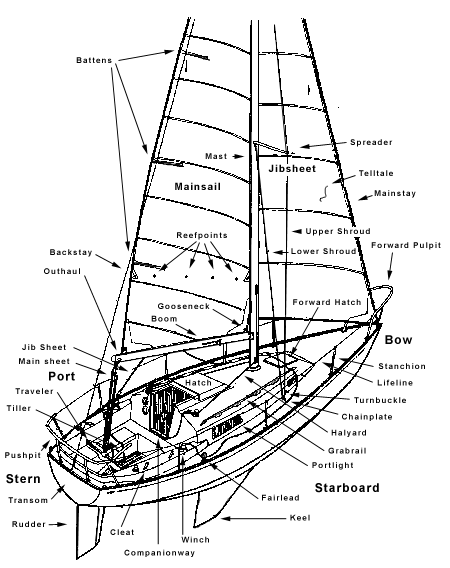
Parts of a Sail
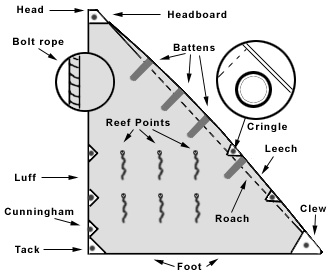
Jib Trim

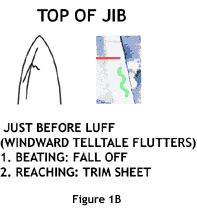
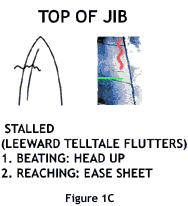
Knots
There are hundreds of kinds on knots that can be used on sailboats but you
can do almost anything by learning six basic ones.
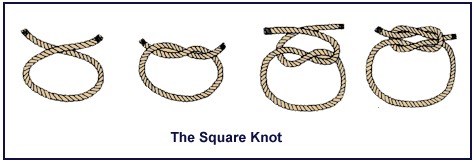
Reef Knot (Square Knot) - The reef knot is useful for Sail ties when
reefing or furling the Sail. To tie this knot follow the steps in the illustrations
from left to right.
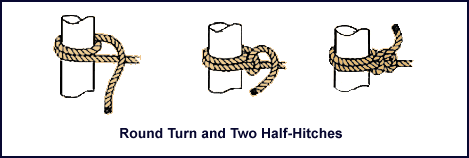
Round Turn and 2 Half Hitches - This knot can be used almost any time
you want to tie something to something else. It is often used to tie fenders
to a stanchion or lifeline. Although it won't keep a line from slipping on a
spar it stay tied even when jiggled. To tie this knot follow the steps in the
illustrations from left to right.
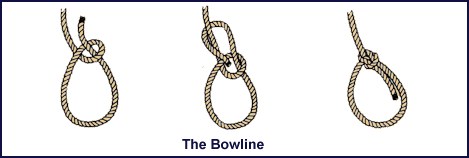
Bowline - The bowline, called the king of knots, is used to tie an eye
onto the end on a line. It is used for attaching the jib sheets to the jib.
A correctiy made bowline is very secure, yet easy to untie. To tie this knot
follow the steps in the illustrations from left to right.
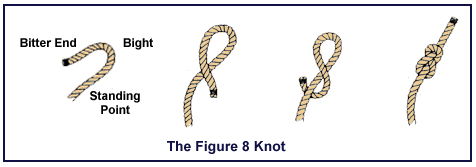
Figure Eight - This knot is useftil as a stopper knot. Stoppers or put
on the end of sheets to keep them from running through the fairleads. To tie
this knot follow the steps in the illustrations from left to right.
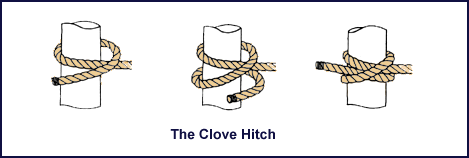
Clove Hitch - The clove hitch is good for tying lines around solid objects.
One use is in tying the tiller up to the main sheet. It may come undone if jiggled.
To tie this knot follow the steps in the illustrations from left to right.
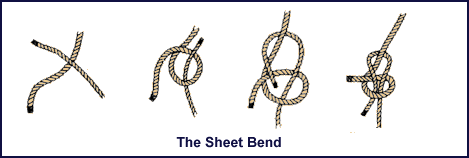
Sheet Bend - The sheet bend is used to tie two lines together, end to
end. It is meant to be used when the lines are about the same size. If lines
are very different or are slippery a double sheet bend is recommended. To tie
this knot follow the steps in the illustrations from left to right.
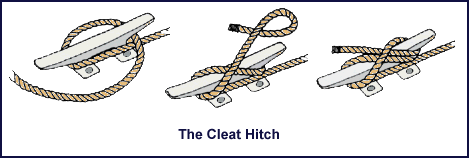
Cleat Hitch - The cleat hitch is the way a line is secured to a deck
cleat. To tie this knot follow the steps in the illustrations from left to right.
RIGHT OF WAY RULES
Whenever two boats try to occupy the same water at the same time, a right of way situation exists. When this happens, one boat is obligated to give way to the other. The boat that is supposed to give way is Called the give way vessel and the other one is called the stand on vessel The stand on vessel should keep to its course so the skipper of the give way vessel can get out of the way without collision. There are specific rules to use in determining which vessel is which.
Motor vs. Sail: A motor boat is any vessel using an engine regardless of whether it is a sailboat or a motorboat. A sailboat is considered to be a motorboat even if the SailS are up as long as the engine is running. A sailboat that is sailing generally has the right of way over motorboats. But there are some exceptions.
- Large motor vessels are given the right of way in channels where it is difficult for them to maneuver. In the case of ships, the whole San Francisco Bay is considered to be channeled so that ships always have right of way in the Bay.
- In narrow channels such as Redwood Creek, motor vessels as small as 65 feet may be limited in maneuverability enough to make them the "stand on" vessel.
- Motor vessels that are restricted in maneuverability due to the special job they are doing are "stand on" This could be anything from towing nets to dredging, pile driving, or tending buoys.
- Motor vessels don't have to give way to sail boats that are motoring when the rules for motorboats give the motor vessel right of way. (When motoring, a sailboat is treated like any other motorboat.
- If a motor vessel is experiencing some kind of difficulty restricting its maneuverability, it is given right of way.
- If a sailboat is overtaking a power boat, the power boat has the right of way.
Head On - When two motor boats approach each other head on, both boats turn to the right and pass each other port to port.
Crossing - When motor boats paths cross, the boat on the other's right is stand on and the one on the other's left is the give way boat This is like two cars coming to a 4-way stop except that a give way boat would alter course to go behind the other boat
Sailboats When encountering sailboats that are sailing, motorboats generally should give way. If you are motoring in a sailboat, you should give way to sailboats that are sailing.
Rules for Sailboats
Port Tack vs. Starboard Tack
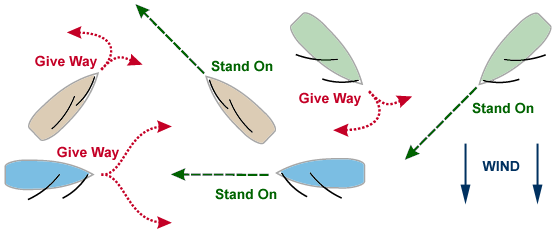
Anytime Two Sailboats Are On Opposite Tacks - The Boat On Starboard Tack
Has The Right Of Way
Windward vs. Leeward
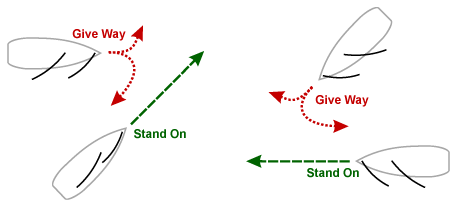
Anytime Sailboats Are on the Same Tack The Boat Most To Leeward Has Right
of Way
Overtaking - The overtaking vessel should give way regardless of tack
or whether sailing or motoring. The notable exception to this rule is in the
case of large vessels that are confined to the channel due to draft. Even at
minimum speed, ships usually move faster than sailboats, therefore you should
keep an eye out behind your boat as well as ahead.
Overtaking Vessels

Overtaking Boats Give Way to Boats Being Overtaken
General Rules - Whenever there is a risk of
collision and it appears that the give way boat is not taking appropriate action,
it is the duty of the stand on boat to avoid the collision by altering course.
Having the right of way is a poor excuse for having a collision - alterations
in course to avoid a collision should be made obvious enough so that the other
skipper can see what you are doing. Sometimes you can tell if you are on a collision
course by the compass bearing to the other vessel. If the bearing remains steady,
collision is imminent unless someone changes course.
Sometimes it is difficult to see in all directions on a sailboat, especially
when sailing close hauled. The jib can block 25% of view from the cockpit. The
area of obstruction occurs on the leeward side from straight ahead to abeam.
It just so happens that when you are close hauled or close reaching, sailboats
close hauled or close reaching on the opposite tack will remain within this
blind spot sometimes right until the time of collision. It's important to have
a crew member keep an eye out to leeward when ever the jib obstructs your view.
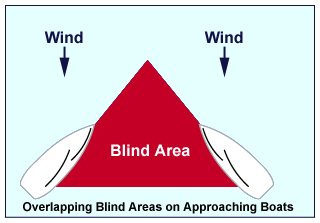
Signal Flags

NOTICE: Some pages have affiliate links to Amazon. As an Amazon Associate, I earn from qualifying purchases. Please read website Cookie, Privacy, and Disclamers by clicking HERE. To contact me click HERE. For my YouTube page click HERE